A tagline for enterprise-effectiveness
What’s a simple tagline that we can use to help guide conversations about enhancing of enterprise-effectiveness?
My own preference is this: things work better when they work together, on purpose.
Okay, I’ll admit that that doesn’t quite give us the full effectiveness-summary set that we’ve explored in the previous posts in this series – efficient, reliable, elegant, appropriate, integrated:
To cover the whole of that set, the tagline would have to be quite a bit longer: “things work better when they work together, efficiently, reliably, simply and elegantly, on purpose”. Which is kinda unwieldy, and too long for a simple tagline. Not quite what we’d want.
So yeah, let’s stick with the shorter version for now, and allow the other effectiveness-themes in that set (and many other themes too) to arise naturally from the conversation.
But how do we use that tagline? What conversations? Why? And for what purpose, what outcomes? Let’s strip it right down to an even shorter form – “things work better together on-purpose” – and explore what arises as we go word-by-word through that short-form tagline…
— “things”
What ‘things’? What is the ‘What’ of the enterprise?
This is in a deliberately-blurry sense at first – “What’s happenin’?” “Oh, y’know, things, stuff, whatever…” – and from there work slowly towards specifics. There’s a literal sense to this, of course – physical things, physical stuff – but a broader sense too, around information, relations, brands, reputation, all that kind of stuff as well. So, some questions to play with around ‘things’:
- What are the ‘things’ of this enterprise?
- Who or what decides what things are in-scope for this enterprise, and which aren’t?
- What happens to those things? In what ways do they change? – become transformed into or used in other things? (And what happens to those other things?)
- What are the lifecycles for those things? – Create, Read, Update Delete, and all that?
- Who or what decides what should or should not happen to each thing? Why?
- Who owns each of these things? In what sense of ‘own’? And what stage in each lifecycle for each thing?
Another term for ‘things’ is assets. In effect, things or ‘resources’ become ‘assets‘ when someone has responsibility for them – whether they know it or not. We also need to note that each thing or asset will express one or more of the asset-dimensions:
As a quick summary of the distinctions between these asset-dimensions:
- physical: tangible, independent (it exists in its own right), exchangeable (I can pass the thing itself to you), alienable (if I give it to you, I no longer have it)
- virtual: non-tangible, semi-independent (exists in its own right, but requires association with something physical to give it accessible form), semi-exchangeable (I can pass a clone or imperfect-copy of the thing to you), non-alienable (if I give it to you, I still have it)
- relational: semi-tangible (each end of the link is tangible), dependent (it exists between its nodes, and may be dropped from either end), non-exchangeable (if I have it, I cannot give it to you – though I can create conditions under which you could create your own equivalent copy), inherently non-alienable (there is nothing that can be given to others)
- aspirational (‘meaning’): semi-tangible at best (one end of the link may be tangible, but at least one node will be virtual), dependent (it exists between its nodes), non-exchangeable (as for relational-asset), inherently non-alienable (as for relational-asset)
These distinctions are crucially important, and a lot of people get them mixed up. For example, trying to ‘control’ information as if it’s physical is rarely a good idea – especially if our business-model assumes that that’ll work. (Which it doesn’t, as the media-industries and others discovered to their cost…)
Two other points to note. One is that people – business-folk especially – will often ask why money, for example, isn’t there as a separate dimension in its own right. That’s because it isn’t: technically-speaking, money is just information about a belief, in other words a combination of the virtual and aspirational dimensions. You’re welcome to include money as a separate dimension if you wish – because, yeah, a lot of people do seem to want it as such – but be aware that doing so can kinda confuse things further down the track, such as when we need to compare contexts where alternatives to ‘currencies’ may be in play.
The other is that, by intent, there’s no mention of people as such. That’s because people are not things – and we need to hammer that point home rather hard sometimes. Yes, relations with people are a kind of ‘thing’; beliefs are a kind of ‘thing’; reputation is a kind of ‘thing’; and yes, those are in that mapping of asset-dimensions (typically as combinations of relational-dimension and aspirational-dimension). Relations with people are assets (and important ones, too), but people themselves are not – and failure to understand that distinction is a really common cause of ineffectiveness in the enterprise. You Have Been Warned, etc?
— “work”
What is ‘work’? What is the ‘How’ of the enterprise, that we could aim to make more effective?
The challenge here is almost the opposite to that for ‘things’: it’s too easy for discussions about work to become constrained to existing assumptions, whereas for this we need to keep exploration more open for as long as possible. Some questions to play with around ‘work’:
- What is ‘work’, within the enterprise?
- What needs to be done on or to or with all of those ‘things’ of the enterprise?
- Who or what does that work?
- Who decides what work is to be done? Does this differ from the person who does the work?
- Who is responsible or accountable for that work? Is such responsibility freely chosen, or assigned by another? What are the consequences for that choice?
- If the work is automated, who designs or operates that automation? Who provides oversight or checks on that design and operation of automation?
If we think of work in terms of services, then the Enterprise Canvas framework can provide a useful visual-checklist to guide explorations about work within the enterprise:
Every element and exchange on the Enterprise Canvas frame represents some kind of work that needs to be done on some kind of ‘things’. It may be helpful to use a semi-structured method such as the ‘This’ game to guide exploration of the work, the ‘things’ and their interdependencies.
— “better”
What do we mean by ‘better’? What is the quality of the enterprise, such that we know when the enterprise is more, or less, effective in terms of its aims and goals?
This is sometimes a bit harder to explore at first, not least because it barely rates any mention in any of the mainstream enterprise-architecture frameworks: it doesn’t appear at all in Zachman, for example. Some questions to play with around ‘better’:
- What, in terms of the overall enterprise, is ‘better’ or ‘not-better’?
- How would you identify when ‘better’ has or has not been achieved? What metrics or other identifiers would you use?
- Who determines the values and metrics upon which ‘better’ or ‘not-better’ is based?
- For which groups of stakeholders – whether ‘internal’ or ‘external’ – does each aspect of ‘better” or ‘not-better’ apply?
- Where those metrics differ between stakeholder-groups, how would you obtain and monitor appropriate balance for and between each of the stakeholder-groups?
- Where those metrics and outcomes differ across various aspects or domains of the enterprise, how would you obtain and monitor appropriate balance for and between each of the domains, and across the overall enterprise as a whole?
That last pair of questions is extremely important, yet often missed – though it’s where and why we so often end up with local efficiency, for example, at the expense of overall effectiveness. The old adage “act local, think global” definitely applies here…
One place to start is with the effectiveness-set that we’ve used throughout this series – efficient, reliable, elegant, appropriate, integrated:
We do need to recognise, though, that that’s only a starter-set, one that’s common to every organisation and enterprise. To go further, we need to explore all of the other qualitative ‘-ilities’ that might apply in the context, such as flexibility, adaptability, extensibility, scalability and so on – all of the so-misnamed ‘non-functionals‘ of the respective enterprise. It would also be wise to explore the often-crucial distinctions between fragility, robustness, resilience and antifragility that may apply in each aspect of the enterprise and its context.
— “together”
What do we mean by ‘together’? What underpins the integration of activities and everything else in the enterprise, to work together as a unified whole?
As above with ‘better’, exploring this aspect of effectiveness can be much harder than we might expect – though in this case more often from fixed assumptions about what ‘togetherness’ supposedly ‘should’ be, rather than what it needs to be for things to work well. Some questions to play with around ‘together’:
- What are the key interdependencies across the enterprise? (You may well need to go quite a lot deeper than you might at first expect, though the ‘Just Enough Detail‘ principle should always apply.)
- Who is responsible or accountable for each interdependency? (The answer should never be ‘No-one’…)
- What are the interfaces and exchanges between each of the services that make up the activities of the enterprise? What interdependencies do each of these interfaces and exchanges create? (Again, the ‘Just Enough Detail’ principle should apply here.)
- Who is responsible and accountable for each of these interfaces and exchanges? (Again, the answer should never be ‘No-one’.)
- What checks and balances are needed to link everything together across the enterprise in most optimal way overall? – allowing for the dynamics of change across the enterprise?
- What conversations between stakeholders are needed across the enterprise, to ensure optimal integration and ‘togetherness’ throughout the enterprise?
- Who is responsible and accountable for each of those conversations, and the outcomes of those conversations? (Once again, the answer should never be ‘No-one’.)
As before, the Enterprise Canvas framework and the ‘This’ game may well be useful to guide this kind of exploration.
One of the most common concepts for ‘togetherness’ is alignment to a defined business-strategy. Whilst that’s obviously an important aspect of ‘togetherness’, it’s only one aspect amongst many – and if we fail to acknowledge and work with that fact, we can get ourselves into very deep trouble without understanding how or why. We need to remember at all times that the enterprise-in-scope is always larger than the organisation-in-scope – a point we explored in the previous post ‘Effectiveness for enterprise-effectiveness‘:
The interdependencies, interfaces, exchanges, checks and balances, and conversations needed for ‘togetherness’ apply to relations between all stakeholders in the overall enterprise – not solely to those interactions that seemingly centre around the organisation itself. Again, we forget that fact at our peril…
— “on-purpose”
What do we mean by ‘on-purpose’? What is the ‘Why’ for the enterprise, that underpins everything that it is and does?
In principle, ‘on-purpose’ should be straightforward: every action in the enterprise should take place in context of a shared-purpose – sometimes described as the ‘vision’ for the shared-enterprise. Every service acts as a means to move from what we already have – the ‘realised-ends’ in the existing real-world – towards that vision, the ‘desired-ends’:
Yet as with ‘Together’, the real challenge here is that there are often some too-rigid preconceptions about what the ‘Why’ is for an enterprise, and even more for who gets to define it – many of which preconceptions may well be dangerously wrong… So, some questions to play with around ‘on-purpose’:
- What is the purpose of the enterprise, as a central rallying-point for a ‘bold endeavour’?
- How is that enterprise-purpose identified?
- Who defines that purpose? – or does it kind of define itself, POSIWID-style?
- What values devolve from the shared-purpose? How do these help to identify what ‘better’ would mean within the enterprise, and how to keep on-track towards both ‘better’ and ‘on-purpose’?
- How do we identify when actions are more towards, or less towards, ‘on-purpose’? What can we do to bring strategies and actions more towards ‘on-purpose’?
- What is the purpose or intent of each stakeholder-group in relation to that shared enterprise-purpose?
- What action needs to be taken to ensure that those differing purposes balance out in relation to each other and to the shared-purpose? How can we ensure that the purposes of one or more stakeholder-groups do not attempt to override all of the others?
It’s perhaps crucial to note that every stakeholder has their own aim(s) and purpose(s) – many of which are changing all the time anyway. For example, a bar/restaurant chain wants to make a financial profit, the franchisee wants to run a business, the employees want meaningful work that also supports their own families, the city wants to attract visitors to the town, the police want no trouble from anyone, whilst the customer – right now, though perhaps not at any other time – just wants a good night out with something good to eat and drink. And the shared-enterprise is the point where all of these disparate purposes coincide.
Which is why, for enterprise-effectiveness, we need to understand that no-one ‘possesses’ the enterprise – it is itself, it just ‘is’. And likewise no-one ‘possesses’ the shared-purpose for that shared-enterprise – it is itself, it just ‘is’. To design a business-model in relation to that shared-enterprise, we need to know what that shared-purpose is – but we also need to remember that we do not define that shared-purpose, nor do we possess it. This is a crucial point that many business-folk still seemingly fail to understand…
The usual approach to business-models and the like would typically assume that the organisation ‘is’ the enterprise, and that everyone else exists only in relation to the organisation and its own needs, aims and purpose. This shift in perspective about the nature of enterprise above warns us that that conventional view is literally self-centric – and fundamentally wrong, causing serious misconceptions about the nature of value-propositions and the like. Instead, building on that model of the shared-enterprise above, we can summarise the requirements for ‘on-purpose’ visually as follows:
Nigel Green and Carl Bate’s ‘VPEC-T‘ – Values, Policies, Events, Content, Trust – is one framework that’s proved very useful to identify and resolve clashes between stakeholders and their respective purposes. Overall, though, one of the simplest tactic is to keep focus on those core questions: “What is ‘on-purpose’? – and how do we get there?”
So that’s all of the key elements for that tagline for enterprise-effectiveness: things work better when they work together, on-purpose. I hope you find it useful!
Your omments / suggestions / experiences, perhaps?
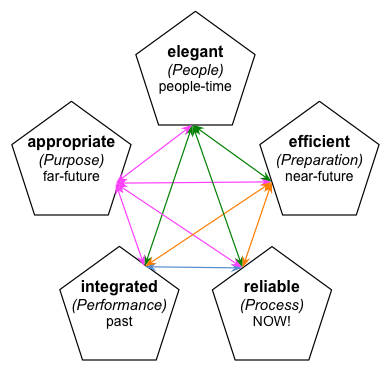
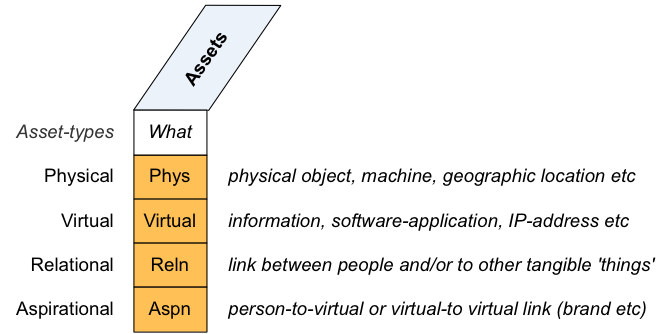

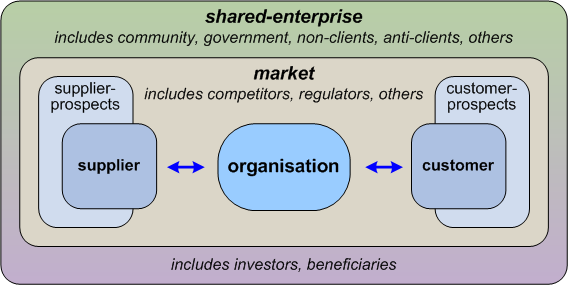
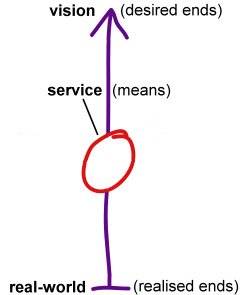
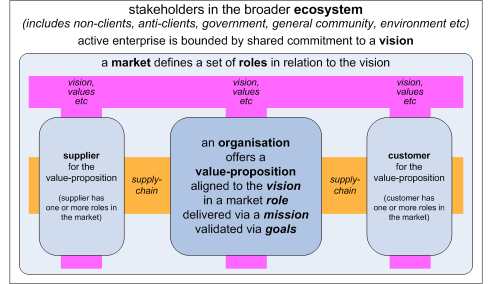
0 Comments on “A tagline for enterprise-effectiveness”